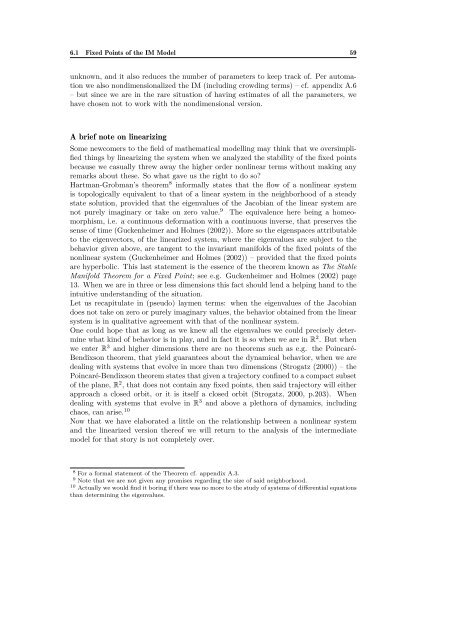nr. 477 - 2011 - Institut for Natur, Systemer og Modeller (NSM)
nr. 477 - 2011 - Institut for Natur, Systemer og Modeller (NSM)
nr. 477 - 2011 - Institut for Natur, Systemer og Modeller (NSM)
Create successful ePaper yourself
Turn your PDF publications into a flip-book with our unique Google optimized e-Paper software.
6.1 Fixed Points of the IM Model 59<br />
unknown, and it also reduces the number of parameters to keep track of. Per automation<br />
we also nondimensionalized the IM (including crowding terms) – cf. appendix A.6<br />
– but since we are in the rare situation of having estimates of all the parameters, we<br />
have chosen not to work with the nondimensional version.<br />
A brief note on linearizing<br />
Some newcomers to the field of mathematical modelling may think that we oversimplified<br />
things by linearizing the system when we analyzed the stability of the fixed points<br />
because we casually threw away the higher order nonlinear terms without making any<br />
remarks about these. So what gave us the right to do so?<br />
Hartman-Grobman’s theorem 8 in<strong>for</strong>mally states that the flow of a nonlinear system<br />
is topol<strong>og</strong>ically equivalent to that of a linear system in the neighborhood of a steady<br />
state solution, provided that the eigenvalues of the Jacobian of the linear system are<br />
not purely imaginary or take on zero value. 9 The equivalence here being a homeomorphism,<br />
i.e. a continuous de<strong>for</strong>mation with a continuous inverse, that preserves the<br />
sense of time (Guckenheimer and Holmes (2002)). More so the eigenspaces attributable<br />
to the eigenvectors, of the linearized system, where the eigenvalues are subject to the<br />
behavior given above, are tangent to the invariant manifolds of the fixed points of the<br />
nonlinear system (Guckenheimer and Holmes (2002)) – provided that the fixed points<br />
are hyperbolic. This last statement is the essence of the theorem known as The Stable<br />
Manifold Theorem <strong>for</strong> a Fixed Point; see e.g. Guckenheimer and Holmes (2002) page<br />
13. When we are in three or less dimensions this fact should lend a helping hand to the<br />
intuitive understanding of the situation.<br />
Let us recapitulate in (pseudo) laymen terms: when the eigenvalues of the Jacobian<br />
does not take on zero or purely imaginary values, the behavior obtained from the linear<br />
system is in qualitative agreement with that of the nonlinear system.<br />
One could hope that as long as we knew all the eigenvalues we could precisely determine<br />
what kind of behavior is in play, and in fact it is so when we are in R 2 . But when<br />
we enter R 3 and higher dimensions there are no theorems such as e.g. the Poincaré-<br />
Bendixson theorem, that yield guarantees about the dynamical behavior, when we are<br />
dealing with systems that evolve in more than two dimensions (Str<strong>og</strong>atz (2000)) – the<br />
Poincaré-Bendixson theorem states that given a trajectory confined to a compact subset<br />
of the plane, R 2 , that does not contain any fixed points, then said trajectory will either<br />
approach a closed orbit, or it is itself a closed orbit (Str<strong>og</strong>atz, 2000, p.203). When<br />
dealing with systems that evolve in R 3 and above a plethora of dynamics, including<br />
chaos, can arise. 10<br />
Now that we have elaborated a little on the relationship between a nonlinear system<br />
and the linearized version thereof we will return to the analysis of the intermediate<br />
model <strong>for</strong> that story is not completely over.<br />
8 For a <strong>for</strong>mal statement of the Theorem cf. appendix A.3.<br />
9 Note that we are not given any promises regarding the size of said neighborhood.<br />
10 Actually we would find it boring if there was no more to the study of systems of differential equations<br />
than determining the eigenvalues.
















